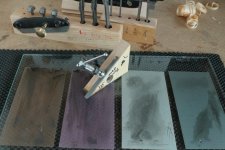Sanderxpander
Member
- Joined
- Sep 19, 2017
- Messages
- 419
Being new to woodworking I've been "told" (mainly by YouTube and various forums) about the importance of sharp tools. It's almost useless to buy chisels or planes if you have no way to sharpen them. The local store sold me a Japanese waterstone and one of those jigs to set and keep the angle on your blade. But reading about the process it honestly seems incredibly tedious - soaking the stone for at least 15 minutes before use, constantly managing the flatness of the soft stone and keeping both sides parallel etc., not to mention spending a lot of time actually sharpening items (with limited skill).
Thinking there must be an easier way I found the obvious Tormek machines which do seem faster but again with the stones and the water etc...
So another alternative seems the Robert Sorby ProEdge. Does anyone have one? Is this a quicker and more hassle free solution? Do you still get sharp clean edges? Are there other options as easy/quick, or even better?
By the way I appreciate that grinding/whetting by hand is part of the craft but there's only so much time in a day and I enjoy "making stuff" a lot more than I do "fixing" tools. I'm already annoyed having to square the fence on my miter saw etc.
Thinking there must be an easier way I found the obvious Tormek machines which do seem faster but again with the stones and the water etc...
So another alternative seems the Robert Sorby ProEdge. Does anyone have one? Is this a quicker and more hassle free solution? Do you still get sharp clean edges? Are there other options as easy/quick, or even better?
By the way I appreciate that grinding/whetting by hand is part of the craft but there's only so much time in a day and I enjoy "making stuff" a lot more than I do "fixing" tools. I'm already annoyed having to square the fence on my miter saw etc.

